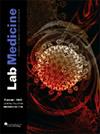在炎症性肠病患者中意外发现日本二扇叶菌
IF 1
4区 医学
Q4 MEDICAL LABORATORY TECHNOLOGY
引用次数: 0
摘要
该病例患者为52岁男性,有溃疡性结肠炎病史。他的炎症性肠病无症状;他在门诊进行了内窥镜检查,以常规监测他的病情。他接受了下内镜检查以排除结肠发育不良;他在接受手术时没有服用任何药物。自27个月前最近一次结肠镜检查以来,患者未出现腹泻或直肠出血,并报告未出现提示病情变化的症状。患者没有已知的过敏史。我们没有与病人讨论他是否可能摄入了生的或未煮熟的鱼。直肠指检结果正常。下腔镜检查,我们发现轻度炎症,其特征是易碎,颗粒状,线性糜烂,从肛门到直肠的连续和圆周模式的血管丧失。与先前的检查结果相比,结果没有变化,胃肠病学家认为与患者已知的溃疡性结肠炎一致。直肠内可见一良性无根息肉;该实体被活检并送往病理部门。结肠和回肠末端的其余部分没有明显的外观。在升结肠中发现偶然寄生绦虫(图1)。本文章由计算机程序翻译,如有差异,请以英文原文为准。
An Unexpected Finding of Diphyllobothrium nihonkaiense in a Patient with Inflammatory Bowel Disease
The patient in this case was a 52-year-old man with a known history of ulcerative colitis. His inflammatory bowel disease was asymptomatic; he presented for an outpatient endoscopy for routine surveillance of his condition. He underwent lower endoscopy to exclude colonic dysplasia; he was taking no medications at the time of his procedure. The patient had experienced no diarrhea or blood loss from the rectum and reported no symptoms that would suggest changes in his condition since his most recent previous colonoscopy 27 months previously. The patient had no known allergies. We did not discuss with the patient whether he might have ingested raw or undercooked fish. Results of a digital rectal examination were normal.
### Endoscopic Findings
On lower endoscopic examination, we discovered mild inflammation characterized by friability, granularity, linear erosions, and loss of vascularity in a continuous and circumferential pattern from the anus through the rectum.
Compared with the results of previous examinations, the findings were unchanged and were believed by the gastroenterologist to be consistent with the patient’s known ulcerative colitis. A benign-appearing sessile polyp was also noted in the rectum; this entity was biopsied and sent to the pathology department. The remainder of the colon and the terminal ileum had an unremarkable appearance. An incidental parasitic tapeworm was discovered in the ascending colon (Image 1). The tapeworm was extracted from the ascending …
求助全文
通过发布文献求助,成功后即可免费获取论文全文。
去求助
来源期刊

Labmedicine
医学-医学实验技术
CiteScore
2.50
自引率
0.00%
发文量
155
审稿时长
>12 weeks
期刊介绍:
Lab Medicine is a peer-reviewed biomedical journal published quarterly by the ASCP and Oxford University Press. The journal invites submission of manuscripts on topics related to clinical chemistry and microbiology, hematology, immunology, transfusion medicine, molecular diagnostics, cytology, histology, and laboratory administration and management. Original research, reviews, and case reports are considered for publication. Lab Medicine is indexed (under the title Laboratory Medicine) by the National Library of Medicine and is included in the PubMed database.
 求助内容:
求助内容: 应助结果提醒方式:
应助结果提醒方式:


